Izar, also known as Epsilon Boötis, is the second brightest star in the constellation of Boötes, after Arcturus, and one of the first telescopically observed binary stars.
Key Facts & Summary
- The Epsilon Boötis star system consists of an orange giant star of spectral type K0 II-III, and a blue-white main-sequence star of spectral type A2 V.
- The Epsilon Boötis star system is located at around 203 light-years / 62 parsecs away from the Sun.
- The Epsilon Boötis star system has an absolute magnitude of -1.61.
- The primary star, Epsilon Boötis A, has an apparent magnitude of 2.37 while the secondary star, Epsilon Boötis B, has an apparent magnitude of 5.12.
- The star system appears as a single star to the naked eye, however, both components can be resolved in 3-inch/76 mm aperture or larger telescopes.
- Epsilon Boötis A has 4.6 solar masses, and it is huge, with an estimated 33 solar radii, or 3.300% the sun’s radius.
- Epsilon Boötis A radiates a lot of energy, it is 501 times brighter than our sun.
- Epsilon Boötis A has a surface gravity of around 2.2 cgs, and it is cooler than our sun, with surface average temperatures at around 4.550 K.
- The rotational velocity of Epsilon Boötis A has been estimated to be at around 10.9 kilometers / 6.7 miles per second.
- Epsilon Boötis B is a much faster spinner than Epsilon Boötis A, with an estimated rotational velocity of around 123 kilometers / 76.4 miles per second
- Much about Epsilon Boötis B remains unknown, however, Epsilon Boötis A has been estimated to have around 37.4 million years. It is much younger than our sun.
- The Epsilon Boötis star system has an estimated radial velocity of around -16.31 km / 10.1 mi per second.
Epsilon Boötis has had many names throughout the ages. It bore the traditional names Izar, Mirak, Mizar, and was also named Pulcherrima by Otto Struve.
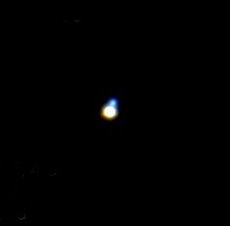
The names Izar, Mirak, and Mizar are from Arabic, translating to veil or the Ionis, while Pulcherrima is of Latin origin, meaning “loveliest.” The three Arabic names, all refer to the star’s position in the constellation of Boötes, marking the celestial Herdsman’s Ioin cloth.
Formation
Epsilon Boötis is a very young star, which formed around 37.4 million years ago. Though young, much of its hydrogen supplies have been already burned out. The star likely formed from a rich molecular cloud of dust and gas. Gravity pulled together the swirling gas and dust to form the second brightest star of Boötes, Epsilon Boötis.
Distance, Size, and Mass
The Epsilon Boötis star system is located at around 203 light-years / 62 parsecs away from the Sun. It is visible to the naked eye and both components can be observed by a 3-inch/76 mm aperture or larger telescope.
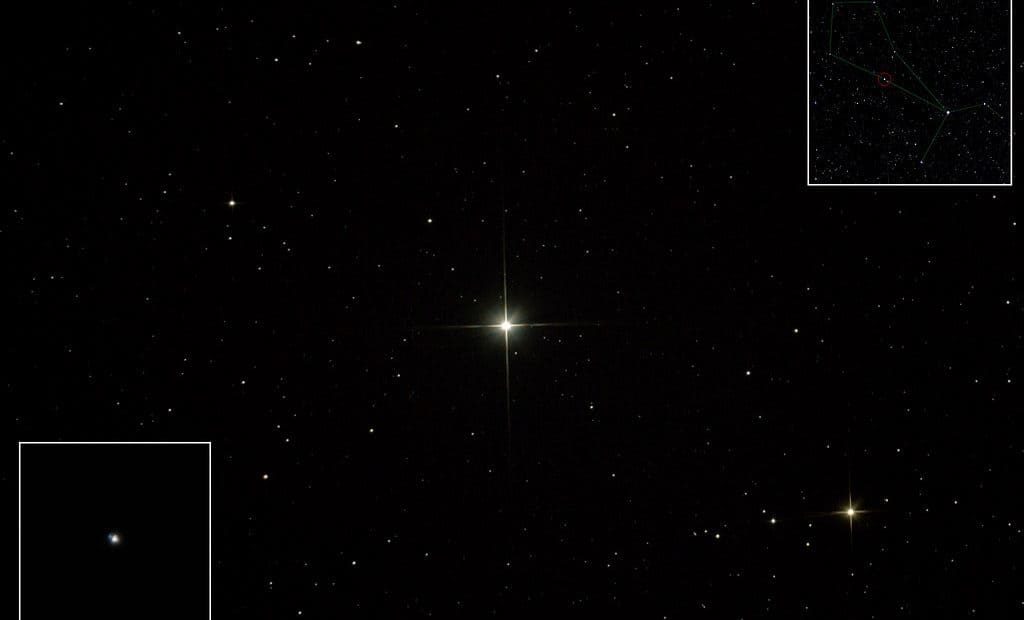
The primary star, Epsilon Boötis A, has 4.6 solar masses, it is thus 460% more massive than our sun. It has an estimated 33 solar radii, or 3.300% the sun’s radius thus it is more than 33 times bigger than our sun.
The secondary star, Epsilon Boötis B, is speculated to be at least 2 times bigger than our sun.
Other Characteristics
Epsilon Boötis A is an orange giant star of spectral type K0 II-III, with an apparent magnitude of 2.37. It has started to fuse helium in its core and has expanded considerably ever since.
The primary star is cooler than our sun, with an estimated surface temperature of around 4.550 K. It is around 501 times brighter than our sun and has a surface gravity of around 2.2 cgs. It spins much faster than our sun, having a rotational velocity of around 10.9 kilometers / 6.7 miles per second.
The secondary star, Epsilon Boötis B, is much hotter than the primary star and our sun, having average surface temperatures of around 8.700 K, or 1.5 times hotter than our sun.
Epsilon Boötis B is a hydrogen-fusing dwarf star of spectral type A2 V and has an apparent magnitude of 5.12. It is 27 times brighter than our sun and it has a rotational velocity of around 123 km / 76.4 mi per second. The Epsilon Boötis star system as a whole has an estimated radial velocity of around -16.31 km / 10.1 mi per second.
Stellar System
The two stars are separated by around 2.852 seconds of an arc which, at a distance of 203 light-years, gives a projected separation of around 185 AU.
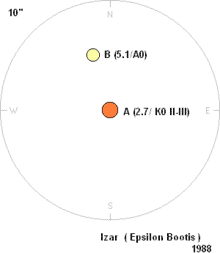
The two components complete one orbit around each other, once every 1.000 years or so.
Location
Izar / Epsilon Boötis is located in the constellation of Boötes, marking the Herdsman’s waistcloth. The constellation of Boötes stretches across 907 square degrees, making it one of the largest northern constellations. The constellation is very prominent in the evening sky during the month of June.
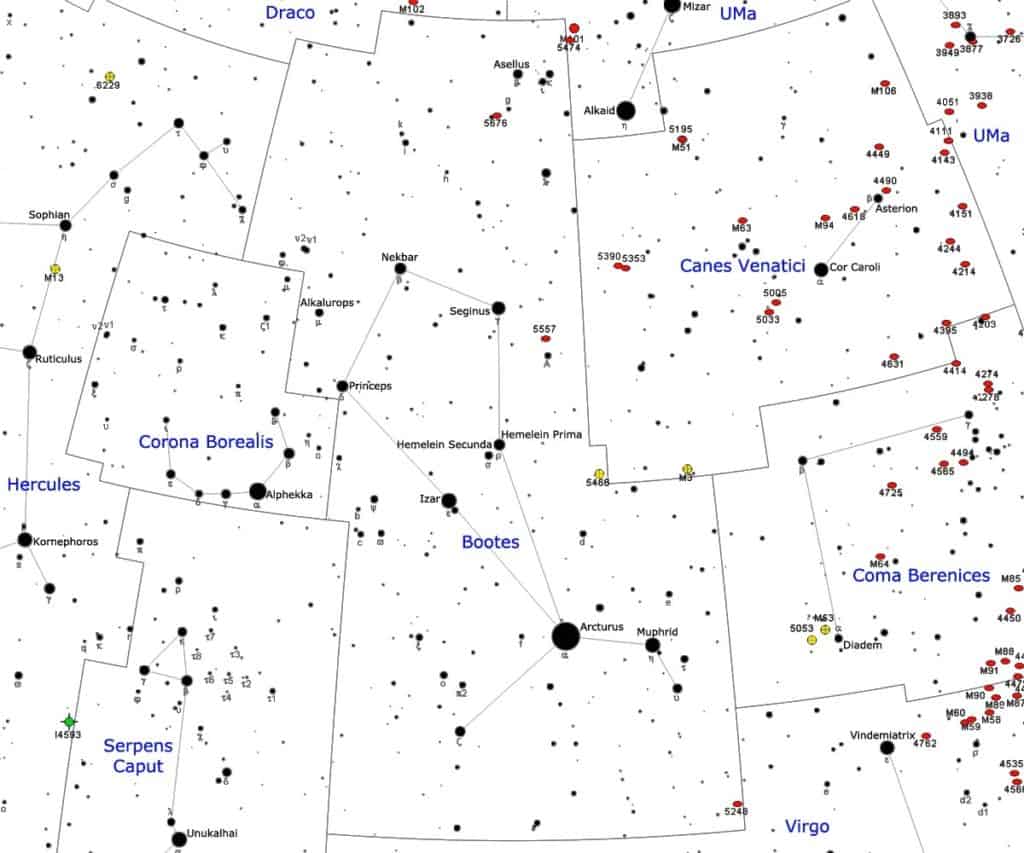
One of the first mentions of the Boötes constellation appeared in Homer’s Odyssey, but it was known even long before that. Epsilon Boötis is one of the brightest stars that form the kite-shaped pattern of Boötes. Epsilon Boötis actually lies to the northeast/left of the brightest star in the constellation, Arcturus.
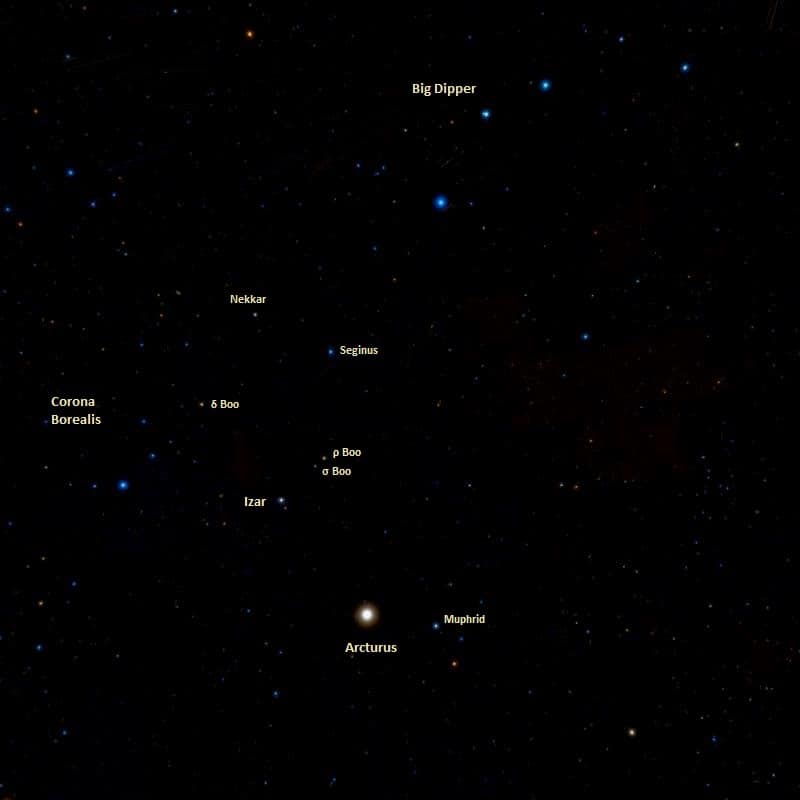
The Future
The primary star, The Epsilon Boötis A, will continue to expand and until its companion will reach its stage, in around one billion years or so, the primary star will already have its outer layers ejected to form a planetary nebula, and leaving behind a faint white dwarf. By this time, Epsilon Boötis B will become the brightest star of the system, eclipsing the former primary star.
Did you know?
- The Egyptian astronomer Al Achsasi Al Mouakket, listed the star as Mintek al Aoua – the belt of the baker or of the shouter – in his 17th-century Calendarium. It was later translated into Latin as Cingulum Latratoris
- The Chinese knew Epsilon Boötis as the First Star of Celestial Lance, an asterism formed by Epsilon, Sigma, and Rho Boötis. It represented a part of the Chinese Root mansion, which represents the chest of the Azure Dragon.
- In 1973, a science fiction writer and also astronomer, named Duncan Lunan claimed to have interpreted a message caught in the 1920s by two Norwegian scientists. He theorized that the message came from a 10,000-year-old satellite orbiting Earth, named the Black Knight. The satellite was supposedly sent by inhabitants of a planet orbiting Epsilon Boötis. He later withdraw his theory and then suspiciously revoke his withdrawal. This story was even reported in the Time magazine.
Sources:
Image source:
- https://www.daviddarling.info/images/Izar.jpg
- https://www.star-facts.com/wp-content/uploads/2019/09/Izar-1024×620.jpg?189db0&189db0
- https://upload.wikimedia.org/wikipedia/commons/thumb/8/83/PositionEpsBoo.PNG/220px-PositionEpsBoo.PNG
- https://www.star-facts.com/wp-content/uploads/2019/09/Bo%C3%B6tes-constellation.jpg
- https://www.star-facts.com/wp-content/uploads/2019/09/Izar-location.jpg?189db0&189db0
